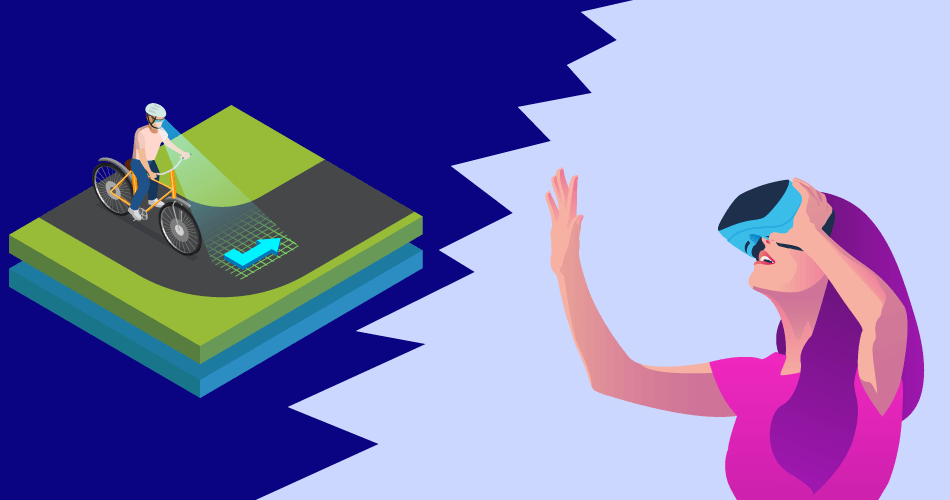
Technology has grown by leaps and bounds. This is the age of computers and the internet, where almost every component of real-life has a virtual counterpart. Perhaps, every field of human activity has found representation in the digital community, with the constantly evolving technological advancements. The days are not far when cyberspace is an all-new dimension of its own, and the doors to this alternate world are slowly becoming bigger, and to some extent, even indistinctive.
AR/VR has a promising market in the future. It is believed that AR/VR shall be the future of corporate training. The ultra-modern equivalent of a vision, it practically saves you the strain of imagination, by presenting to you a prefabricated set-up that can be designed and curated to a great degree of precision.
What is AR/VR?
Perhaps the most advanced human-interactive technology, AR and VR, are gaining immense popularity for their mere scope and wide-spread possibilities.
Augmented reality (AR), is experiencing a real-world environment, where the objects of the real world are intensified by computer-generated perceptual information, using multiple sensory modalities, mainly visual, auditory, and olfactory. It simply means the addition of digital elements to an existing real-life view. Some examples of AR that people use daily are Snapchat and games like Pokémon Go.
Virtual Reality (VR) is a simulated environment that shuts out the real world completely, by immersion in a digitally created world that can be similar or different from the real-world location. It provides digitally produced images/videos, sounds, and sometimes even touch and feel to establish the wholeness of the three-dimensional simulation world.
These ‘extended reality’ technologies are hot property in the tech world, with its mighty scope and endless possibilities.
What is the significance of AR/VR?
If nothing but to show the power of technology, engineers, researchers, and software developers are putting together days and nights to develop AR/VR technology like never before. It can perhaps be due to the excitement of the ability to create a whole new world or the practical use of these in various fields, that is driving the people towards these extended realities.
- Training
AR/VR can be used for real-time training, especially for the emergency-response teams, like fire-fighters, ambulance medical personnel, police, security, etc. This gives them an almost realistic experience of what the actual situation might look like and prepare them for better performance.
In fact, AR/VR can also be used for corporate training, which has proven to be a challenging task due to the unpredictable requirements of circumstances.
Medical personnel, especially surgeons, can undergo training using AR/VR, which can equip them with the necessary practice to perform real-life surgeries.
- Education
It has been scientifically proven that students retain visual information better; hence, converting the text-book contents into an AR/VR universe can assist in better learning. Also, it can offer detailed information that is easy to grasp, and learning can be much bigger than just the four walls of the classroom.
- Medicine and Research
Advance VR can be used to test the scenarios of a medical solution or even research. The fact that AR/VR can produce endless permutations and combinations of circumstances is of extreme benefit to the research field.
- Games and leisure
What can be better than being able to enter into your favorite game! With AR/VR, using tools like the headset, joysticks, and other sensory modules, one can play tennis, go on a hunt, or even play at concerts.
- Design and Visualization
AR/VR is a boon to designers, who can now witness the possible outcome of their proposed design digitally, aiding in correction, modification, or alterations. It can also be used as a communicative medium, to project the visualization of the designers to the clients.
- Defense training
A major civic function of AR/VR can be its use in defense training. It is an undeniable fact that soldiers are faced with the most unpredictable and diverse situations. Now they can at least be prepared to some extent by prior training through AR/VR. They can make a high-risk environment safe for learning.
How is AR/VR the future of Corporate training?
Studies have shown that most companies lose 25% of their new employees within a year, due to poor onboarding. That is, it has been observed that the training experience is very incompatible with what the employees face in their actual jobs. Traditional methods of group-discussions, lectures, online training are somewhat primitive and do not express the entire scope of the job profiles and the corporate world. Hence, leveraging technology in the right way can assist in better training sessions that is more coherent with the real job scenarios.
Discussed below are a few reasons why AR/VR are becoming increasingly important for corporate training:
- The first and perhaps the most important reason is that they enable learning through practical simulation, rather than theoretical concepts. This helps in better understanding and response and has shown to impart better timely implication compared to formal classes or lectures.
- It makes training more innovative, interactive, and enjoyable. When trainees are actually in the scene, it is definitely much more exciting than sitting through lectures for hours together. It provides new ways to demonstrate, illustrate, and explain.
- It can offer the creation of scenarios that are impossible in any other form of training. Price crunch, lack of resources, or space can fail in regular training sessions producing certain crucial circumstances. With AR/VR, there are no limitations on the number of scenarios that can be generated.
- It provides a safe and risk-free environment for learning even the most diverse of situations.
- Training is possible, irrespective of the place or location on the globe. In fact, AR/VR can also enable collaborative training sessions between people who are stationed in different parts of the world, who can be brought together in the simulated dimension. In fact, it is not required for the trainer and the trainees to be in the same space in the real world!
- Since the AR/VR technology offers a training world that can be customized and designed to high precision, it becomes easier for new employees to fit into their roles and assimilate their tasks and the organizational culture quicker and better, thus saving time.
- AR/VR training can enable immersive training with an in-built performance analyzer and track recorder. This helps in better evaluation of the trainees and can also help in focused training.
- Statistics have predicted an increase in productivity and profitability with the introduction of AR/VR technology into corporate training, owing to the culturing of a more engaged workforce.
Augmented reality (AR) and virtual reality (VR) have opened a myriad of opportunities for companies to scout for talents and train their picks in the most advanced ways possible. With the rising need for new-age training provisions, corporates just cannot wait to include AR/VR simulation programs into their training sessions. It is an undeniable fact that the current world is becoming highly engaged and tangled with technology, and perhaps it is just a blurry line between what is real and what is digital. However, the brighter side of this development is the new spectrum of training facilities offered by the AR/VR technology in the corporate sector.




